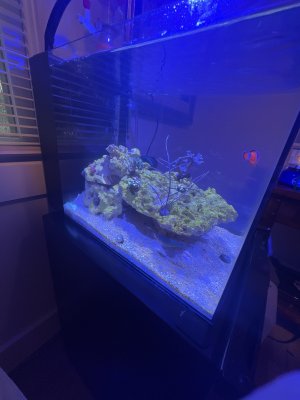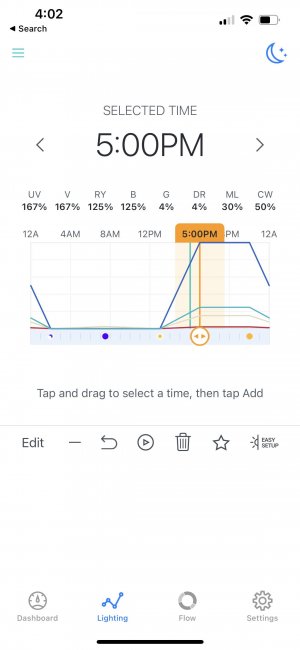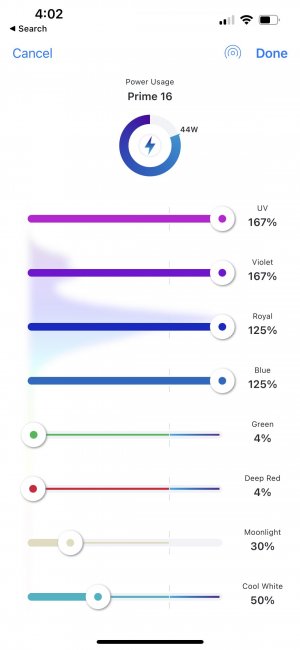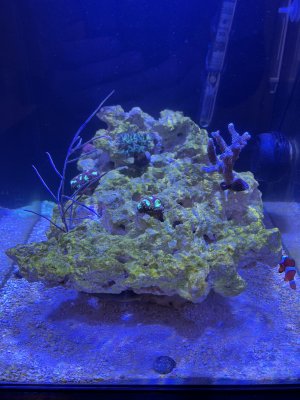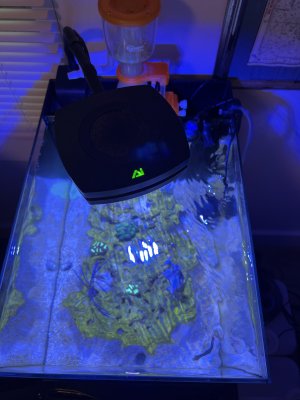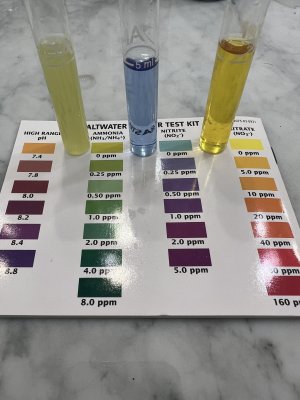Hi Everyone,
Attached are some images for you to look at. I have a few questions so I will just bullet them below. Hoping someone more experienced can help me out.
Tank Info:
-AI Prime 16 Reef Light (Spectrum and Wattage are below. I used the Bulk Reef Supply conversion for the SPS AB+ spectrum with Aqua Illumination AI Prime 16
-Hygger Protein Skimmer (rated for 57 gallons) Struggling a bit with microbubbles, but also read it needs to break in and develop some slime to stop this
-Waterbox included plastic bio balls in a mesh bag that I just put in the overflow (far left) section of the sump that the water flows through. I ditched the filter socks since they are annoying to buy every week and clog up and then it messes up my ATO
-Waterbox included bag of carbon in a mesh bag that is just plopped on top of the return pump in the farthest right chamber that is just sitting in water (not sure if this is good or bad or harmless)
-The middle chamber has the protein skimmer and nothing else.
-AI Prime light set up is the
-Pump is a AI Nero 3 that is set to a lower flow since its small tank (Set to random reef mode with 1% speed to 5% speed with medium variance)
-Salinity is 1.025
-Water Temp is 76 degrees
-Livestock: 6 line wrasse, Clownfish, Cleaner Shrimp, Clean up crew (snails and hermits)
1. Are my parameters acceptable according to the test? This was 5 min ago as of this post.
2. If they are correct, why am I getting this sprinkle of greenish colored algae on my rocks and on the glass/sand. (I have read this is a precursor to coralline which I hope, but if its not should I be worried?)
3. What types of coral do I even have? (Bought frags from local store) I think they are SPS, but don't know specific names. I think 2 are Favia, 1 is Gorgonia, and I have no idea about the other 2 larger ones. Let me know if you know.
4. Why are the Gorgonia (if not gorgonia the tall skinny one) polyps are retracted?
5. Why is the Anemone in bottom left corner shrunken up? At night when I peak in the tank it is puffed up and looks large and in charge, but under light it looks scared.
6. If you have suggestions for changes please let me know.
Attached are some images for you to look at. I have a few questions so I will just bullet them below. Hoping someone more experienced can help me out.
Tank Info:
-AI Prime 16 Reef Light (Spectrum and Wattage are below. I used the Bulk Reef Supply conversion for the SPS AB+ spectrum with Aqua Illumination AI Prime 16
-Hygger Protein Skimmer (rated for 57 gallons) Struggling a bit with microbubbles, but also read it needs to break in and develop some slime to stop this
-Waterbox included plastic bio balls in a mesh bag that I just put in the overflow (far left) section of the sump that the water flows through. I ditched the filter socks since they are annoying to buy every week and clog up and then it messes up my ATO
-Waterbox included bag of carbon in a mesh bag that is just plopped on top of the return pump in the farthest right chamber that is just sitting in water (not sure if this is good or bad or harmless)
-The middle chamber has the protein skimmer and nothing else.
-AI Prime light set up is the
-Pump is a AI Nero 3 that is set to a lower flow since its small tank (Set to random reef mode with 1% speed to 5% speed with medium variance)
-Salinity is 1.025
-Water Temp is 76 degrees
-Livestock: 6 line wrasse, Clownfish, Cleaner Shrimp, Clean up crew (snails and hermits)
1. Are my parameters acceptable according to the test? This was 5 min ago as of this post.
2. If they are correct, why am I getting this sprinkle of greenish colored algae on my rocks and on the glass/sand. (I have read this is a precursor to coralline which I hope, but if its not should I be worried?)
3. What types of coral do I even have? (Bought frags from local store) I think they are SPS, but don't know specific names. I think 2 are Favia, 1 is Gorgonia, and I have no idea about the other 2 larger ones. Let me know if you know.
4. Why are the Gorgonia (if not gorgonia the tall skinny one) polyps are retracted?
5. Why is the Anemone in bottom left corner shrunken up? At night when I peak in the tank it is puffed up and looks large and in charge, but under light it looks scared.
6. If you have suggestions for changes please let me know.

